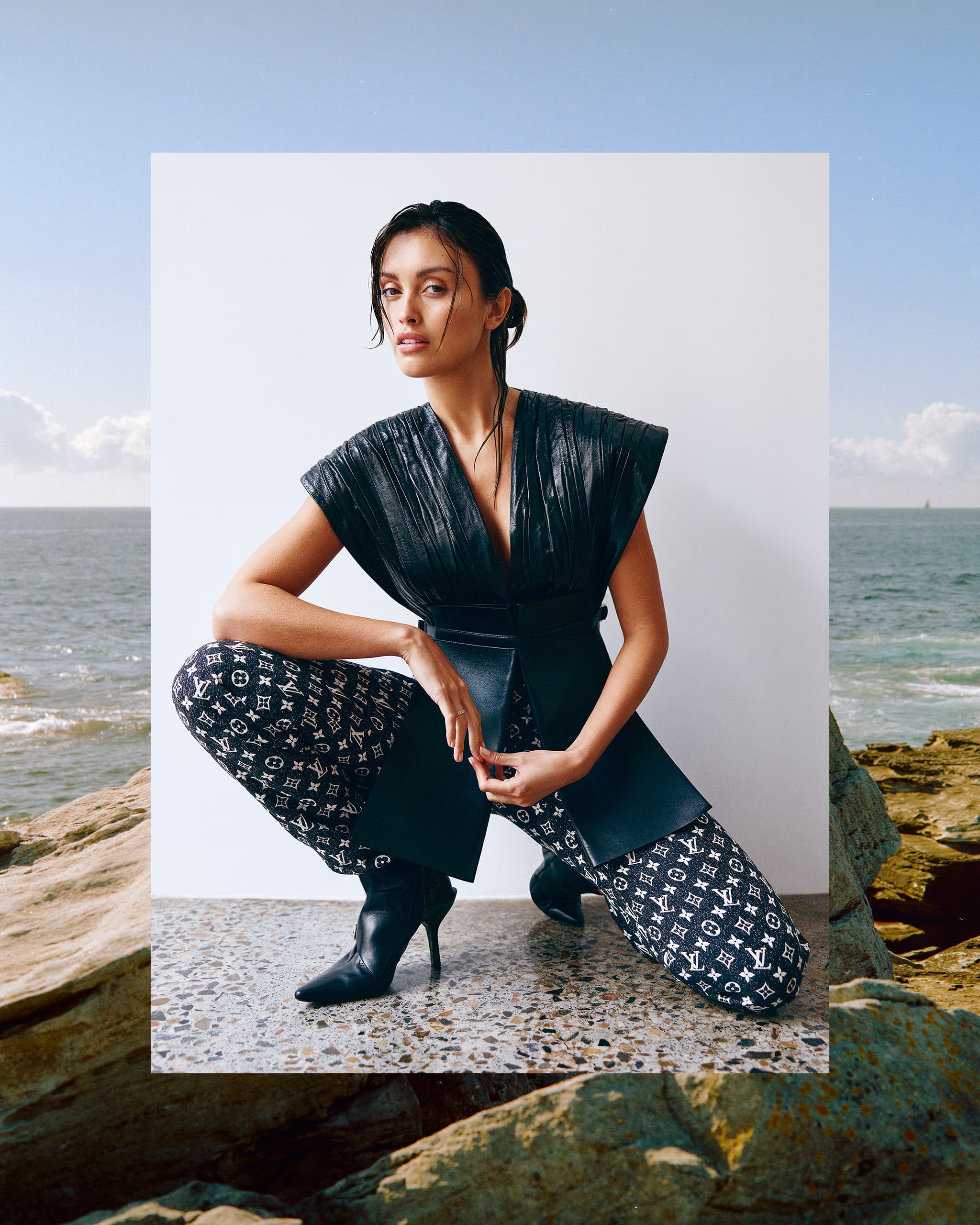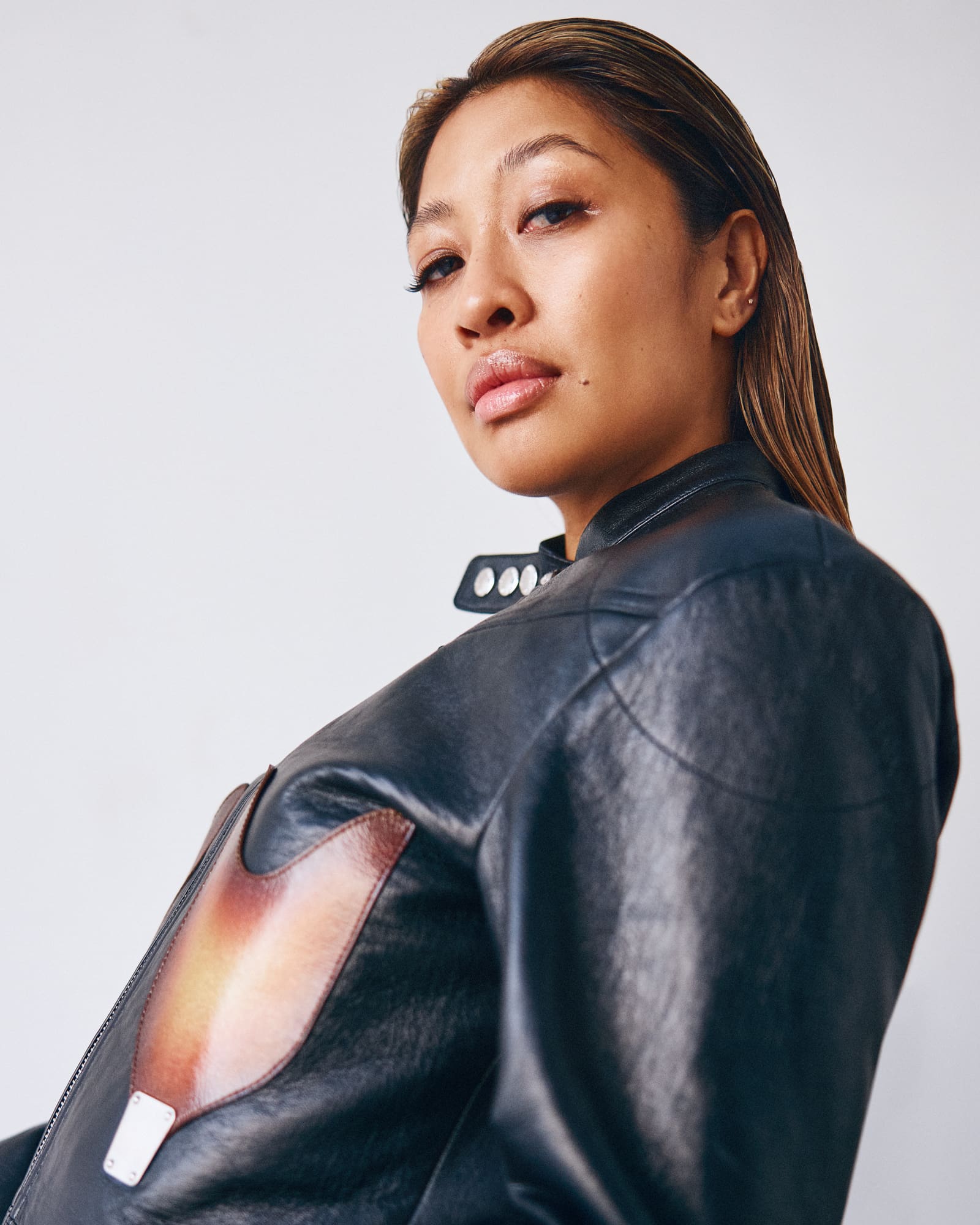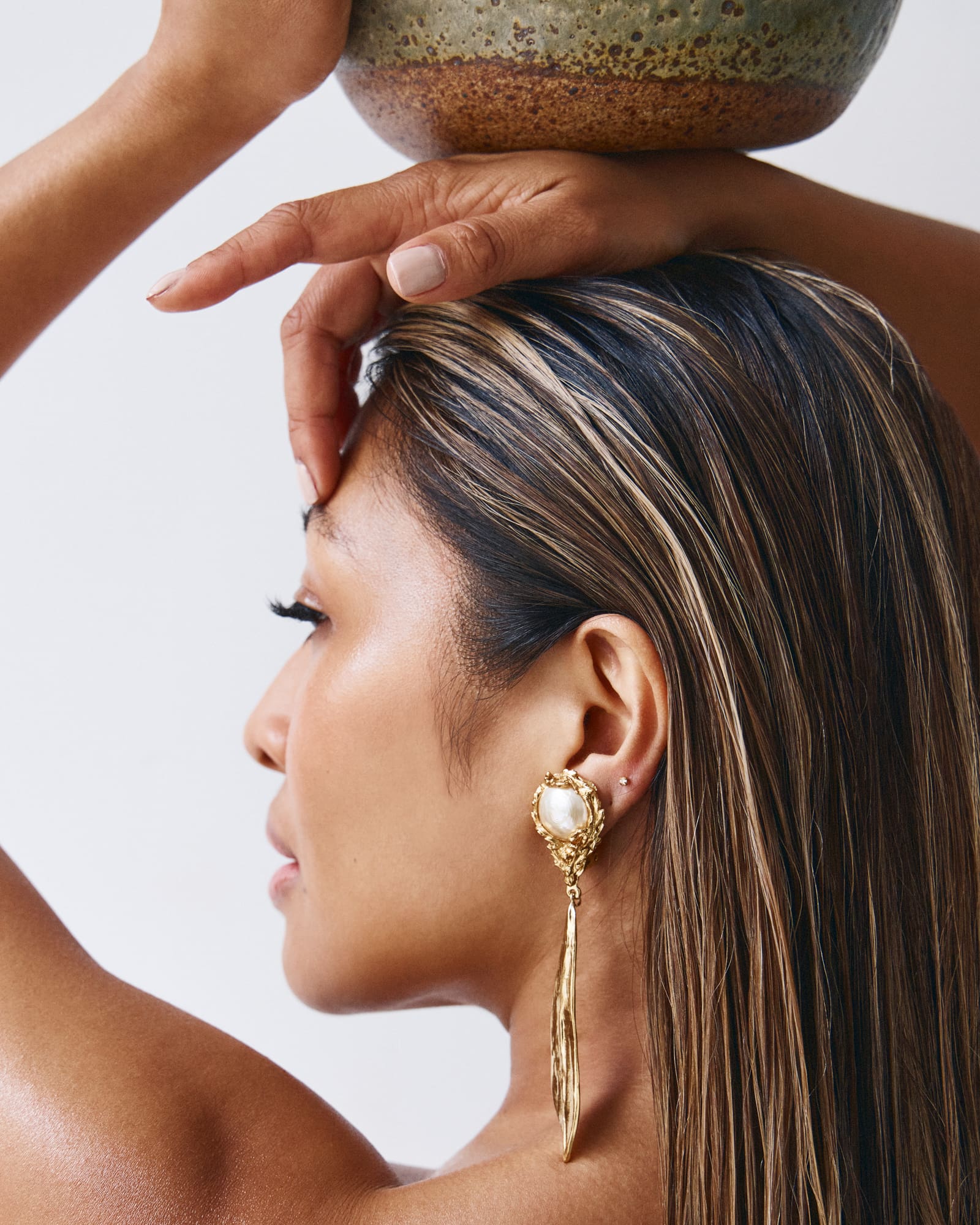LOUIS VUITTON frayed knit top and bermudas, and leather ankle boots. Photo by Diego Lorenzo Jose
Looking from the outside, four Filipino creatives in Sydney revisit their point-of-view while clad in Louis Vuitton’s cruise collection. Carlos Mangubat speaks to four Filipino creatives about their experience.
Our sense of identity is often influenced by our surroundings. More so, what we see in the media and how we relate to it. The media’s portrayal of Asian culture has been subpar up until the last five to 10 years, when we’ve finally seen an increase in visibility and representation in mainstream titles.
Films such as Crazy Rich Asians, Parasite, Minari, and, more recently, Everything, Everywhere All at Once have placed Asian creatives and talent at the forefront. No longer in the shadows, legends like Michelle Yeoh have finally been given the limelight and attention they deserve. They now grace almost every major magazine cover, despite having a long successful career in film and television.
In fashion, brands like Yohji Yamamoto, Issey Miyake, Anna Sui, Opening Ceremony, Vera Wang, and Derek Lam have paved the way for young aspiring Asian designers.
International fashion houses have made more of a conscious effort to ensure their runway casting is diverse, too. The inclusion of models such as Lui Wen, Fei Fei Sun, Soo Joo Park, and Australia’s own Fernanda Ly has changed perceptions of beauty, especially in a competitive, overcrowded, and overexposed international market.
But when it comes to Filipino representation, especially here in Australia, we still have a long way to go. Set on an all Filipino production, I scanned the room and noticed that I was not only surrounded by people who shared the same love for fashion and creativity as me, but a team that looked like me. No longer was I an outsider at work.
Working in Australia, this type of scenario is a rarity, and frankly something I never thought was even possible. Finding and connecting with other Filipino creatives is something I’ve intended on doing, but thought was too difficult to execute without the right network.
Thankfully, in this particular instance (and through a lot of Instagram call-outs), we were able to find each other and create something meaningful. To ensure we continue to create more opportunities, inspire and encourage young people in our community, I spoke to four Filipinos who are making waves in the fashion and creative world in Australia.
Amanda Chan
Model, artist, psychology researcher

“My family is from Cebu. I tried to imbue every part of my life with creativity.
I do a lot of painting which is the traditional form of creativity, but also use my creativity in my psychology research, too, in terms of problem solving and thinking outside of the box. I draw a lot of my Filipino heritage in my work, mostly that sense of community and warmth. I try to imbue all my paintings to have that feeling of community.
The main way I celebrate my culture is through food. I go back home to my family house and we cook a lot of dishes and sit by the table and talk about our lives. It’s really that sense of family and community that’s celebratory of Filipino culture.
The visibility of Pinoys is very important to me. Not only personally—I never saw faces of the Filipino community or culture in the Australian media growing up—but also visibility is relevant to everyone. It’s important to see diverse faces so people can understand and appreciate other cultures. The main way to support each other is by connecting with each other, fostering a sense of community. Speaking to each other and building those friendships.”
Sarah Ellen
Artist, furniture designer, and model

“My mum was born in Quezon City, grew up in Caloocan City and currently lives in Batangas.
For the last decade I’ve been working in the fashion industry, familiarizing myself on the fashion week circuit and collaborating with designers. But recently I’ve been turning my focus to more hands-on practices like painting and more recently furniture design with my latest project, Mod Form. Filipinos are vibrant people (metaphorically speaking). We love to sing, dance and laugh, and, I think that vibrancy has naturally bled into the color palettes I paint with.
Filipino representation is about telling authentic Filipino stories, free of any stereotypes. Filipinos are a proud, diverse community that is largely misunderstood. One thing I’ve specifically noticed is the way the western world tends to group all Asian ethnic groups into one asian stereotype, not appreciating that we all have very different cultures and individual experiences. What I’d like to see is the media telling more stories that show depth and nuance of our multi-ethnic communities so we can dismantle the misconception that all Asians in the media are the same.
Media creates narratives for how Filipinos and other ethnic groups are perceived and treated in the real world. This means it’s not only a representation issue, but also a social justice matter. Media representation signifies social existence and importance to a lot of people. If people don’t see themselves, or people like them represented in the media they consume, they can feel excluded from cultural conversations. It’s important for the youth of the Philippines to see Filipinos in public roles and leadership roles.
I’ve always loved the word Kapwa in Tagalog, there’s no word like it in English, in fact it has no direct translation. Kapwa is the unity of ‘self’ and ‘others.’ To live in the spirit of Kapwa means to embrace our shared identity and to care for our fellow beings. It is one of the core Filipino values and I’d love to extend this into my work, culture, and art.”
Kimberly Cruz
Senior designer in software and ceramicist


“My family is from Manila. We grew up in an area called Valenzuela in Metro Manila. My entire family still lives there.
As a creative person, you’re always trying to push the boundaries somehow, some way. I find that working with brands that are so rigid, I always think “how much further can I push this or how creative can I be within the confines?” I think that’s how I’ve always approached life in general. I never really saw myself as a creative person as it’s such a natural thing for me.
Being Filipino, there’s a lot of humility and gentleness, but at the same time, we are people that are super resilient and resourceful, and that’s how I find I approach my craft.
I am always finding ways to make my materials stretch, I’m not wasteful and I’m super resilient. When things get really hard, that’s when I push back the most. That’s very much what our people are like. Finding ways to gain a sense of community. I’m always trying to build community in my space or find other Filipino people to connect with, that whole kababayan mentality and a strong heart.
Growing up [here] my family and I experienced so much racism. So much racism to the point where I was really ashamed of the dark color of my skin. It wasn’t until 10 years ago, I was finally able to genuinely accept who I was. Even in the Filipino community you’re considered so much more beautiful if you’re mestiza or if you’re half or if your skin is lighter. I always had a complex that I wasn’t beautiful enough because I’m maitim. Growing up in Australia where everyone was maputi and [had] blonde hair, I never really saw anyone in the media that looked like me, I felt like an outsider. I want my nieces, who are also [tan], to be able to look at their Tita and think ‘I can totally do something creative.’ It’s important that our people see themselves in us.
Being an immigrant here, you’re really taught about hustling. You really have to push and work so much harder to prove yourself. We have to fight harder, but I think that makes what you do more meaningful. If you can create awareness that we exist (and we are amazing), that’s the point of it all—leading by example.”
Mason Heaven
Model

“My mother was born in Manila. I have a mixed background of Australian, Filipino, and British.
I live a creative lifestyle. My expression is through drawing or creative movement. I’m not very good at drawing, but I have picked it up recently.
Being proud and visible, even with my ambiguous background, my Filipino background empowers me with modeling. I find it important to me. Seeing the community supported allows me to feel pride within my mother’s culture and her upbringing. If the community is supported then in turn, I am being supported. The way we can support each other is by having an open mind to all cultures, allowing everyone to take their turn and giving them equal time.”
